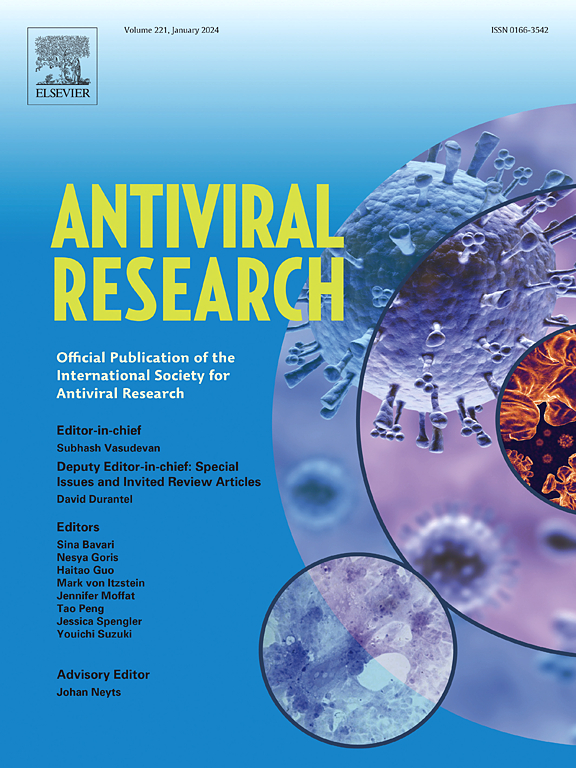n -芳基嘧啶胺(NAPA)化合物是广泛作用的人巨细胞病毒感染和传播抑制剂。
IF 4.5
2区 医学
Q1 PHARMACOLOGY & PHARMACY
引用次数: 0
摘要
人巨细胞病毒(HCMV)是一种β-疱疹病毒,可导致免疫功能低下和免疫调节个体(包括移植受体和新生儿)的疾病负担。fda批准的HCMV药物可表现出耐药性和严重的副作用,包括骨髓毒性、胃肠道紊乱和肾毒性。在之前的研究中,我们发现n -芳基嘧啶胺(NAPA)化合物系列是一类针对早期感染的HCMV抑制剂。在这里,我们描述了两种有效的NAPA类似物MBXC-4336和MBX-4992的抑制活性,它们广泛阻断感染和传播。MBXC-4336和MBX-4992可有效抑制多种HCMV毒株的感染,并通过对感染细胞和病毒基因组水平的量化评估,显著阻止病毒在成纤维细胞和上皮细胞中的传播。此外,NAPA化合物限制了临床HCMV分离株的复制,包括抗更昔洛韦菌株。重要的是,NAPA化合物与更昔洛韦的联合研究证明了对HCMV传播的加性或协同抑制。总的来说,NAPA化合物作为一类新型抗hcmv药物具有开发的治疗潜力。本文章由计算机程序翻译,如有差异,请以英文原文为准。
N-arylpyrimidinamine (NAPA) compounds are broadly acting inhibitors of human cytomegalovirus infection and spread
Human cytomegalovirus (HCMV) is a β-herpesvirus that contributes to the disease burden of immunocompromised and immunomodulated individuals, including transplant recipients and newborns. The FDA-approved HCMV drugs can exhibit drug resistance and severe side effects including bone marrow toxicity, gastrointestinal disruption, and nephrotoxicity. In a previous study, we identified the N-arylpyrimidinamine (NAPA) compound series as a new class of HCMV inhibitors that target early stages of infection. Here we describe the inhibitory activity of two potent NAPA analogs, MBXC-4336 and MBX-4992, that broadly block infection and spread. MBXC-4336 and MBX-4992 effectively inhibited infection by diverse HCMV strains and significantly prevented virus spread in fibroblast and epithelial cells as evaluated by quantifying infected cells and viral genome levels. Further, the NAPA compounds limited replication of clinical HCMV isolates, including a ganciclovir-resistant strain. Importantly, combination studies of NAPA compounds with ganciclovir demonstrated additive or synergistic inhibition of HCMV spread. Collectively, NAPA compounds have therapeutic potential for development as a novel class of anti-HCMV drugs.
求助全文
通过发布文献求助,成功后即可免费获取论文全文。
去求助
来源期刊

Antiviral research
医学-病毒学
CiteScore
17.10
自引率
3.90%
发文量
157
审稿时长
34 days
期刊介绍:
Antiviral Research is a journal that focuses on various aspects of controlling viral infections in both humans and animals. It is a platform for publishing research reports, short communications, review articles, and commentaries. The journal covers a wide range of topics including antiviral drugs, antibodies, and host-response modifiers. These topics encompass their synthesis, in vitro and in vivo testing, as well as mechanisms of action. Additionally, the journal also publishes studies on the development of new or improved vaccines against viral infections in humans. It delves into assessing the safety of drugs and vaccines, tracking the evolution of drug or vaccine-resistant viruses, and developing effective countermeasures. Another area of interest includes the identification and validation of new drug targets. The journal further explores laboratory animal models of viral diseases, investigates the pathogenesis of viral diseases, and examines the mechanisms by which viruses avoid host immune responses.
 求助内容:
求助内容: 应助结果提醒方式:
应助结果提醒方式:


